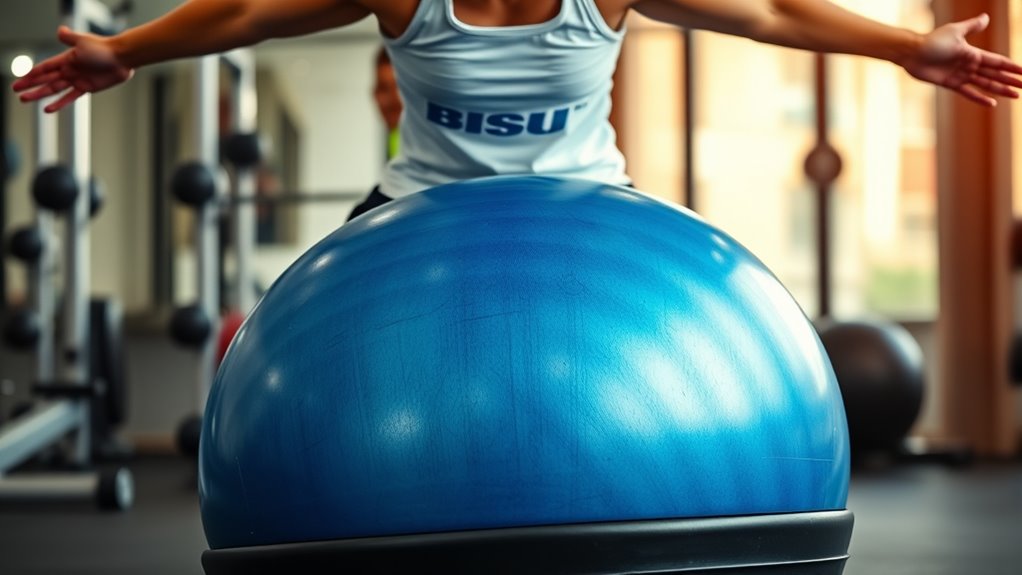To improve your balance, incorporate simple drills like standing on one leg with eyes closed, heel-to-toe walks, or balancing on unstable surfaces. These exercises challenge your proprioception and strengthen your core, leading to better coordination and stability. Start slow and gradually increase difficulty as you grow more confident. Consistent practice helps develop quick reactions and control over your movements. Keep going, and you’ll discover even more effective ways to boost your balance skills.
Key Takeaways
- Incorporate single-leg stands, increasing duration and adding arm movements to challenge stability.
- Use heel-to-toe walking on a straight line to improve balance and proprioception.
- Perform planks and bridges to strengthen core muscles essential for balance control.
- Practice reaching in different directions while maintaining a stable stance to enhance proprioceptive awareness.
- Add unstable surfaces like balance pads or cushions for more effective equilibrium training.

Have you ever wondered how some people move with such grace and stability? It’s usually because they’ve developed a strong foundation in core stability and have honed their proprioception skills through targeted exercises. Building this foundation is essential for effective balance training, as it helps your body respond quickly and accurately to changes in your environment. When your core is stable, your entire body becomes more coordinated and resilient, making it easier to maintain balance during daily activities or athletic pursuits.
A strong core and sharp proprioception are key to graceful, stable movement and effective balance.
To improve your core stability, focus on exercises that engage your abdominal muscles, lower back, and pelvis. Planks are a great starting point; they activate multiple muscles simultaneously and help create a solid core. You can modify planks by extending one arm or leg to increase difficulty, forcing your core to work harder to keep you stable. Another effective exercise is the bridge, where you lie on your back, bend your knees, and lift your hips off the ground, engaging your glutes and core muscles. These exercises lay the groundwork for better balance because they train your body to stabilize itself from the inside out.
Proprioception exercises, which train your body’s awareness of its position in space, are equally important. These exercises challenge your balance by forcing you to respond to unpredictable stimuli or unstable surfaces. For instance, standing on one leg while closing your eyes compels your body to rely on proprioception rather than visual cues. Incorporate simple movements like reaching with one hand while balancing on one foot or practicing heel-to-toe walks along a straight line. These drills enhance your body’s ability to detect shifts in balance and react swiftly, reducing the risk of falls or injuries.
Consistency is key. Incorporate core stability and proprioception exercises into your routine several times a week for noticeable improvements. Start slow, especially if you’re new to balance training, and gradually increase intensity or difficulty as your stability improves. Remember, the goal isn’t just to hold a pose but to challenge your system enough that your muscles and senses adapt. Over time, you’ll notice better coordination, quicker reflexes, and an overall sense of control over your movements.
Frequently Asked Questions
How Often Should I Do Balance Training Exercises Weekly?
You should do balance training exercises about 2 to 3 times a week, following the frequency guidelines for most fitness routines. This allows your muscles and stabilizers to strengthen without overtraining. Incorporate these exercises into your workout recommendations to improve stability, coordination, and reduce injury risk. Consistency is key, so stick to your schedule and gradually increase difficulty as your balance improves for the best results.
Can Balance Drills Help Prevent Falls in Older Adults?
Yes, balance drills can substantially help prevent falls in older adults by improving fall prevention and mobility enhancement. When you regularly practice simple balance exercises, you strengthen muscles and improve coordination, which reduces your risk of falls. Incorporate these drills into your routine a few times a week, and you’ll notice better stability and confidence in daily activities. Consistent practice is key to maintaining safety and independence as you age.
Are There Any Contraindications for Balance Training?
Yes, balance training can have contraindications, especially if you have certain risk factors or medical conditions. If you suffer from severe vertigo, recent surgery, or neurological issues, you should consult your healthcare provider before starting balance exercises. These conditions might heighten your risk of injury during training. Always tailor your program to your individual health status, and seek professional guidance to guarantee safe and effective practice.
What Equipment Is Best for Beginner Balance Exercises?
For beginner balance exercises, stability balls and balance boards are your best equipment options. Stability balls help improve core strength and stability, while balance boards challenge your coordination and proprioception. Start with gentle exercises on these tools, ensuring you have enough space and support. As you progress, you can increase difficulty by standing on the balance board or incorporating movement to build confidence and enhance your overall balance.
How Long Does It Take to See Improvements in Balance?
You can see improvements in your balance within a few weeks with consistent balance training. Typically, if you practice 3-4 times a week, noticeable progress occurs in 4 to 6 weeks. The key is maintaining regular balance training frequency and focusing on proper technique. Stay patient and committed, and you’ll gradually enhance your stability and coordination, making daily activities easier and reducing fall risks over time.
Conclusion
By practicing these simple balance drills, you’ll improve your stability just like a tree roots itself firmly in the ground. Consistency is key—stick with the exercises, and you’ll notice better coordination and confidence in your daily activities. Remember, balancing is a skill that gets easier with time, so stay patient and persistent. Before you know it, you’ll be standing tall and steady, ready to tackle anything that comes your way with the grace of a dancer.








